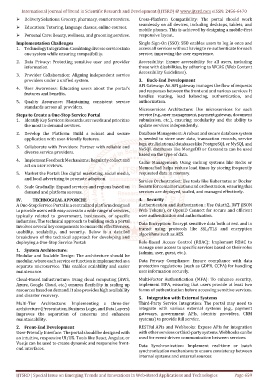Page 669 - Emerging Trends and Innovations in Web-Based Applications and Technologies
P. 669
International Journal of Trend in Scientific Research and Development (IJTSRD) @ www.ijtsrd.com eISSN: 2456-6470
Ø Delivery Solutions: Grocery, pharmacy, courier services. Cross-Platform Compatibility: The portal should work
seamlessly on all devices, including desktops, tablets, and
Ø Education: Tutoring, language classes, online courses.
mobile phones. This is achieved by designing a mobile-first
Ø Personal Care: Beauty, wellness, and grooming services. responsive layout.
Implementation Challenges Single Sign-On (SSO): SSO enables users to log in once and
1. Technology Integration: Combining diverse services into access all services without having to re-authenticate for each
one system while ensuring compatibility. service, improving the user experience.
2. Data Privacy: Protecting sensitive user and provider Accessibility: Ensure accessibility for all users, including
information. those with disabilities, by adhering to WCAG (Web Content
Accessibility Guidelines).
3. Provider Collaboration: Aligning independent service
providers under a unified system. 3. Back-End Development
API Gateway: An API gateway manages the flow of requests
4. User Awareness: Educating users about the portal’s and responses between the front end and various services. It
features and benefits.
handles routing, load balancing, authentication, and
5. Quality Assurance: Maintaining consistent service authorization.
standards across all providers.
Microservices Architecture: Use microservices for each
Steps to Create a One-Stop Service Portal service (e.g., user management, payment gateway, document
1. Identify Key Services: Research user needs and prioritize submission, etc.), ensuring modularity and the ability to
the most in-demand services. update services independently.
2. Develop the Platform: Build a robust and secure Database Management: A robust and secure database system
application with user-friendly features. is needed to store user data, transaction records, service
logs, etc. Relational databases like PostgreSQL or MySQL and
3. Collaborate with Providers: Partner with reliable and NoSQL databases like MongoDB or Cassandra can be used
diverse service providers.
based on the type of data.
4. Implement Feedback Mechanisms: Regularly collect and Cache Management: Using caching systems like Redis or
act on user reviews. Memcached helps reduce load times by storing frequently
5. Market the Portal: Use digital marketing, social media, requested data in memory.
and local advertising to promote adoption.
Service Orchestration: Use tools like Kubernetes or Docker
6. Scale Gradually: Expand services and regions based on Swarm for containerization and orchestration, ensuring that
demand and platform success. services are deployed, scaled, and managed effectively.
IV. TECHNOGICAL APPORCHE 4. Security
A One-Stop Service Portal is a centralized platform designed Authentication and Authorization : Use OAuth2, JWT (JSON
to provide users with easy access to a wide range of services, Web Tokens), or OpenID Connect for secure and efficient
typically related to government, businesses, or specific user authentication and authorization.
industries. The technical approach to building such a portal Data Encryption: Encrypt sensitive data both at rest and in
involves several key components to ensure its effectiveness, transit using protocols like SSL/TLS and encryption
usability, scalability, and security. Below is a detailed algorithms such as AES.
breakdown of the technical approach for developing and
deploying a One-Stop Service Portal: Role-Based Access Control (RBAC): Implement RBAC to
manage user access to specific services based on their roles
1. System Architecture: (admin, user, guest, etc.).
Modular and Scalable Design: The architecture should be
modular, where each service or function is implemented as a Data Privacy Compliance: Ensure compliance with data
separate microservice. This enables scalability and easier protection regulations (such as GDPR, CCPA) for handling
maintenance. user information securely.
Cloud-Based Infrastructure: Using cloud computing (AWS, Multi-Factor Authentication (MFA): To enhance security,
Azure, Google Cloud, etc.) ensures flexibility in scaling up implement MFA, ensuring that users provide at least two
resources based on demand. It also provides high availability forms of authentication before accessing sensitive services.
and disaster recovery.
5. Integration with External Systems
Multi-Tier Architecture: Implementing a three-tier Third-Party Service Integration: The portal may need to
architecture (Presentation, Business Logic, and Data Layers) integrate with various external systems (e.g., payment
improves the separation of concerns and enhances gateways, government APIs, identity providers, CRM
maintainability. systems) to provide full service.
2. Front-End Development RESTful APIs and Webhooks: Expose APIs for integration
User-Friendly Interface: The portal should be designed with with other services or third-party systems. Webhooks can be
an intuitive, responsive UI/UX. Tools like React, Angular, or used for event-driven communication between services.
Vue.js can be used to create dynamic and responsive front- Data Synchronization: Implement real-time or batch
end interfaces.
synchronization mechanisms to ensure consistency between
internal systems and external sources.
IJTSRD | Special Issue on Emerging Trends and Innovations in Web-Based Applications and Technologies Page 659

